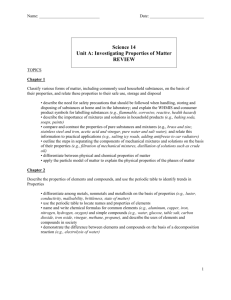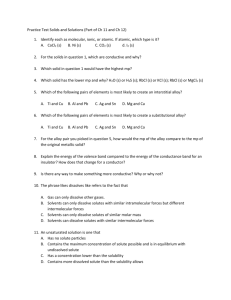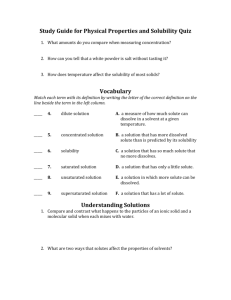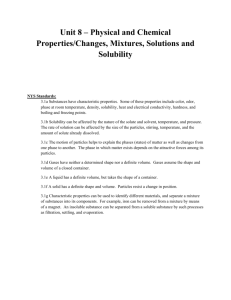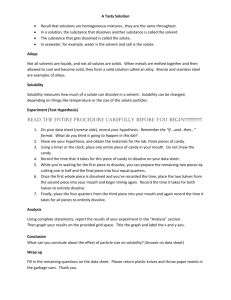LS Ch 18 complete notes - Saint Joseph High School
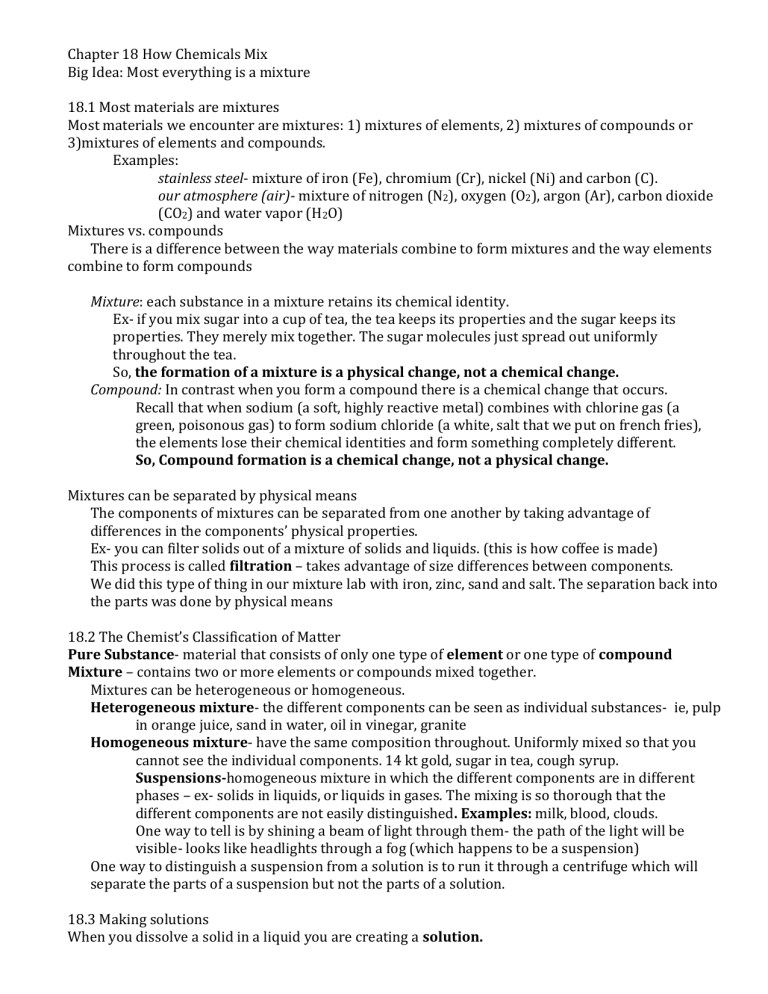
Chapter 18 How Chemicals Mix
Big Idea: Most everything is a mixture
18.1 Most materials are mixtures
Most materials we encounter are mixtures: 1) mixtures of elements, 2) mixtures of compounds or
3)mixtures of elements and compounds.
Examples:
stainless steel- mixture of iron (Fe), chromium (Cr), nickel (Ni) and carbon (C).
our atmosphere (air)- mixture of nitrogen (N
2
), oxygen (O
2
), argon (Ar), carbon dioxide
(CO
2
) and water vapor (H
2
O)
Mixtures vs. compounds
There is a difference between the way materials combine to form mixtures and the way elements combine to form compounds
Mixture: each substance in a mixture retains its chemical identity.
Ex- if you mix sugar into a cup of tea, the tea keeps its properties and the sugar keeps its properties. They merely mix together. The sugar molecules just spread out uniformly throughout the tea.
So, the formation of a mixture is a physical change, not a chemical change.
Compound: In contrast when you form a compound there is a chemical change that occurs.
Recall that when sodium (a soft, highly reactive metal) combines with chlorine gas (a green, poisonous gas) to form sodium chloride (a white, salt that we put on french fries), the elements lose their chemical identities and form something completely different.
So, Compound formation is a chemical change, not a physical change.
Mixtures can be separated by physical means
The components of mixtures can be separated from one another by taking advantage of differences in the components’ physical properties.
Ex- you can filter solids out of a mixture of solids and liquids. (this is how coffee is made)
This process is called filtration – takes advantage of size differences between components.
We did this type of thing in our mixture lab with iron, zinc, sand and salt. The separation back into the parts was done by physical means
18.2 The Chemist’s Classification of Matter
Pure Substance- material that consists of only one type of element or one type of compound
Mixture – contains two or more elements or compounds mixed together.
Mixtures can be heterogeneous or homogeneous.
Heterogeneous mixture- the different components can be seen as individual substances- ie, pulp in orange juice, sand in water, oil in vinegar, granite
Homogeneous mixture- have the same composition throughout. Uniformly mixed so that you cannot see the individual components. 14 kt gold, sugar in tea, cough syrup.
Suspensions-homogeneous mixture in which the different components are in different phases – ex- solids in liquids, or liquids in gases. The mixing is so thorough that the different components are not easily distinguished. Examples: milk, blood, clouds.
One way to tell is by shining a beam of light through them- the path of the light will be visible- looks like headlights through a fog (which happens to be a suspension)
One way to distinguish a suspension from a solution is to run it through a centrifuge which will separate the parts of a suspension but not the parts of a solution.
18.3 Making solutions
When you dissolve a solid in a liquid you are creating a solution.
The solid separates from each other and spreads out evenly throughout the liquid so it appears to disappear. It is only spread out, however.
Terms:
Solvent- the component present in the largest amount (what does the dissolving)
(s)- other components present in smaller amounts (what is being dissolved)
Types of solutions
To make a solution a solute must dissolve in a solvent
Whether something dissolves in another is a function of their electrical attraction for each other. The stronger the attraction, the greater the ability to dissolve.
There is a limit to how much of a given solute can be dissolved in a given solvent. At that point it is said to be saturated with solute.
Saturated solution- a solution containing the maximum amount of solute that will dissolve in its solvent.
Unsaturated solution- a solution that is capable of dissolving additional solute.
18.4 Concentration and the Mole
The quantity of solute dissolved in a solution is described in mathematical terms by the solution’s concentration- which is the amount of solute dissolved per amount of solution
Concentration = amount of solute/amount of solvent
18.5 Solubility-the ability of solute to dissolve in a solvent
Solubility depends on the submicroscopic attractions between the solute particles and the solvent particles
The greater the attraction, the greater the solubility.
If a solute has any appreciable solubility in a solvent, it is said to be soluble in that solvent
Solubility is also dependent on the attraction of solute particles to each other.
Ex- if you were to dissolve sugar in water, the water must first pull the sugar molecules away from each other and get in between them. This limits how much sugar can be dissolved in water. Eventually you run out of water molecules.
Solubility changes with temperature
For many solids, their solubility increases with an increase in temperature. This does not hold true for all solids but most will have increased solubility when a solvent is heated.
Ex- you can dissolve more sugar in a glass of hot tea than a glass of cold tea.
Other solids aren’t affected as much (the solubility of sodium chloride- table salt- isn’t really affected by temperature)
Solubility of gases
The solubility of gases is actually the opposite of the solubility of solids.
The solubility of gases goes down when the temperature rises and up when the temperature drops.
You can dissolve more oxygen in a stream when it’s cold.
Rate of solubility – how quick something dissolves
Making solids smaller increases the surface area of the solids exposing more to the solvent increasing the rate or speed of solubility.
Stirring solids forces the solute and solvent particles to come in contact with each other more thereby increasing the rate of solubility

